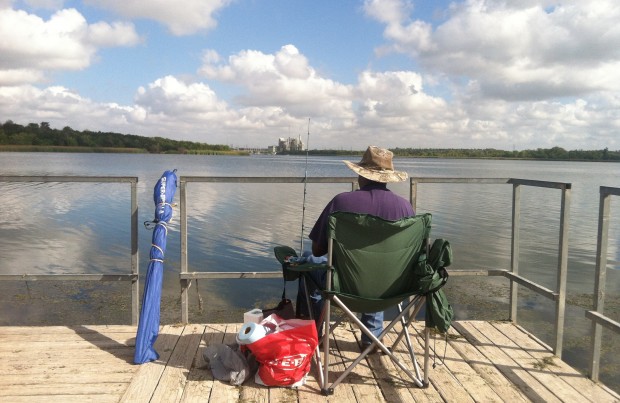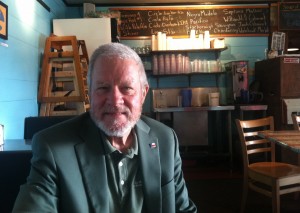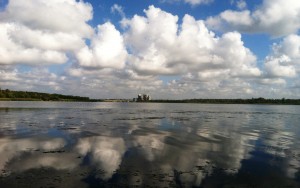As Drought Persists, Cities Look to Texas ‘Lakes’ to Answer Needs

Photo by Mose Buchele
Austin's Decker Lake is used for electricity production and recreations. But it could be re-purposed for municipal water use.
The funny thing about Walter E. Long Lake: most people don’t know it exists.
The lake, tucked into a rural-feeling part of North East Austin is big, by Austin standards. It can hold more water than Austin’s two central city Lakes -Lake Austin and Lady Bird Lake- combined. It was created to host a power plant, which it’s done for for nearly 50 years. That’s how it got its other name: Decker Lake.
But Last week, Austin’s city council voted on a plan to wean Austin off Decker Power Plant electricity, opting to shutter the plant to lower citywide emissions. If that happens, the lake could serve as Austin’s a new city reservoir.
“It’s a body of water most people don’t know about. Some people use it, you’ll see fishing boats out there on the lake,” says Sharlene Leurig, who works at Ceres, a non-profit specializing in sustainability. “But for the most part it’s the unappreciated stepchild of the lakes we have here in Austin.”

Courtesy of CERES
Sharlene Leurig of CERES is chairing an effort to find small-scale options to extend Austin's water supply.
Leurig chaired a city task force to plan Austin’s long term water strategy. It suggested re-purposing Decker Lake to add to Austin’s supply.
“Austin is not in a good spot,” she says “The city of Austin is one of the largest cities that has just one source of water.”
While most of the water in Decker Lake is currently pumped in from the Highland Lakes (Austin’s main water supply), Leurig says it would be useful for the city to maintain it as a reservoir where it could, potentially, catch more rainfall, or store rain that falls in other parts of the city.
“In the last year or two the water that has come, when we’ve gotten rains storms, has not flowed into lake Travis,” she says. “Its been falling downstream of that. And because none of the lakes downstream of are operated to store water it means that we’re just washing that water down to the Gulf.”
If used as a reservoir, water from Decker Lake could be sent downstream to contribute to “environmental flows,” which would keep more water in Austin’s main reservoirs in the Highland Lakes, or the city could also build infrastructure to make Decker Lake a water source in its own right.
“It’s not what it was designed for but, as we look as a city at the ways that we can find water in the very near term if we have to tap into resources. It’s one of the best candidates we have,” she says.
Looking to Lakes
It’s not the first time thirsty communities have tried something like this. There are other lakes in Texas built for flood control and power generation that now serve as water supplies.
The Texas Water Development Board told StateImpact Texas it doesn’t keep data on what reservoirs have been re-purposed, but a quick look at their list of Texas Lakes shows they are out there. Lake Texoma, for example, began its life as a flood control reservoir, as did Wright Patman Lake.
As populations grow, planners view existing lakes as low hanging fruit. There’s no need to build a new reservoir, the water’s already there. But, pulling more water from existing reservoirs is politically tricky, says Andy Samson of the The Meadows Center for Water and the Environment.
“After the drought of record or the drought of the 1950s, we built something over 200 reservoirs in the state. Each of them was built for a particular infrastructure purpose, flood control, water supply, power plant cooling,” Samson says. “Not one of these was built for recreational purposes, or as a community amenity.”
It’s just that that’s how people started to see them. “That created economic impacts in the areas, attracting tourists and later constituents in the areas who were accustomed to using the lakes for recreation, not as a resource,” says Sansom. “That is exacerbated in the teeth of the drought.”Across the state small scale water wars are being fought over how much water will be moved from existing reservoirs. The conflict over water in the Highland Lakes, which has pit lakeside communities and the City of Austin against downstream rice farmers, is perhaps the highest profile fight. But there are others.
Residents around Lake Granbury blame state policymakers for low lake levels. In Lake Palestine, fishermen worry about the impacts of a new pipeline for Dallas city water. In Austin, owners of expensive lakefront property were upset by a proposal to lower Lake Austin by a few feet as a water-saving measure.
The Lower Colorado River Authority –the agency that was exploring the plan- quickly walked away from that idea. But the City of Austin task force is suggesting something similar.
“Unfortunately the people who bought on Lake Austin don’t realize that it was designed to be a variable level lake. That wasn’t the expectation when they bought, but that was its purpose,” says Leurig.
A Painful Compromise
There’s been some push back on the Decker Lake proposal as well. Austin Energy, the city’s electric utility, opposes the idea of shutting down the plant. Some lake-goers are upset because the proposal would dramatically drop lake levels.
“If we’ve got water problems they ought to stop bringing so many people into town,” Jim Robinson, a recreational boater said on a recent weekday after a morning on the lake.
But he agreed that it might some day be necessary to re-purpose Decker Lake.
“If it became an absolutely destitute situation, we’d have to use the water for people. Yeah,” he said. “There’s no doubt about that.”
For water planners like Leurig that time is fast-approaching.
“Whether it’s this drought or the drought or it’s the drought that comes after this cause there will be another drought,” she says. “At some point we’re all going to have to compromise on the expectations of what water does for us what we get from it.”
She says it’s a compromise that will happen across Texas as populations grow and supplies dwindle. That doesn’t mean it will be an easy one.




